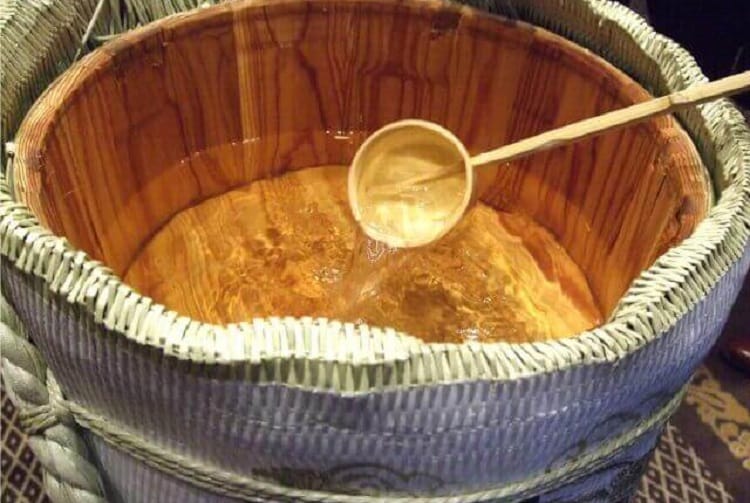
When the candy and sake mother are completed, the process of “Moromizu” will begin.
The purpose of making moromi isMake alcohol fermentation in earnestis. By the way, alcohol fermentation is occurring even at the stage of making sake. The finished liquor contains about 15% alcohol.
Moromi's general method of making “three-stage preparation”
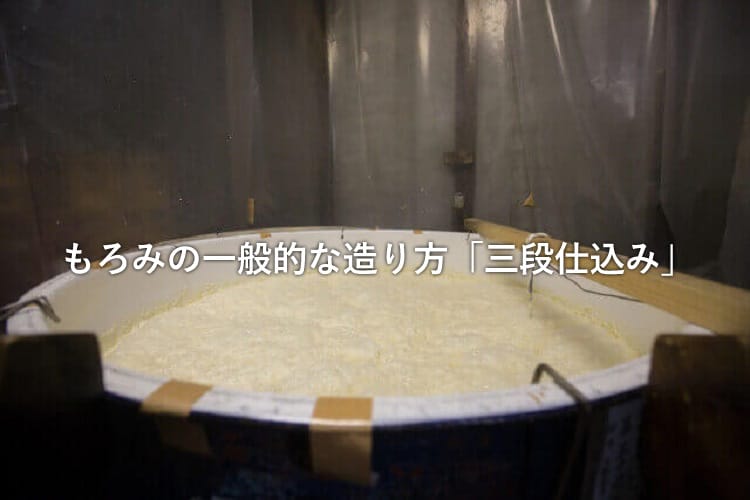
Moromi is made by adding sake mother, rice bran, steamed rice and water to the moromi tank. As a procedure,First, put the mother of liquor into the mashing tank, and then add the rice cake, steamed rice, and water into the tank in several batches..
It is a general preparation method to add rice bran, steamed rice, and water in three portions.Three-stage preparationIs called.
The reason why we dedicate 1 times instead of 3 times is to make safe sake. If you put a lot of steamed rice and water at once,Because yeast and acid dilute rapidly, there is an increased risk that microorganisms that adversely affect sake brewing will propagate..
For this reason, 3 times are charged little by little,It is necessary to gradually change the environment in the tank so that the yeast can grow smoothlyIt is
This three-stage process was established in the Edo period. Since then, most sake breweries have made sake using this three-stage method.
Specific process of “three-stage preparation”

Three-stage preparation is usually done in 4 days. I will introduce the process in detail.
・ First day of 1
First day. In the tank for moromi,We will add the brewer and about 1 / 6 of water and water. Then, while adding steamed rice of about 1 / 6, stir well to mix evenly.
This process"First time"Is called. It is also called “preparation”. By the way, the ratio of rice cake and steamed riceAbout 2: 3The amount of sake motherAbout 6 to 7%.
The purpose of the first addition isFurther growth of yeast cultured in liquoris. For that purpose, it is charged at a relatively high temperature.
In order to perform fine temperature control and smooth growth and fermentation of moromi, it is charged in a small tank called `` sosuke tank '' and then transferred to a mash tank when adding mash Sometimes taken. It seems that high-quality sake such as Ginjo Sake is often made using this method.
By the way, suddenly charging with a large moromi tank from the beginning is commonly called "suppon preparation". Unfortunately, the origin of the name doesn't seem to be clear.
By the way, there is a person who develops the theory that the mechanism of the hole that rises from the abyss on the stage of Kabukiza is called "Supon", so it may come from that. For your reference, it is only the imagination of that individual.
・ Day 2 Dance
The next day after the first addition, the whole 1 day preparation will be closed. this"dance"Is called.Cover the tank and measure the growth of the yeast.
There are various theories about the origin of the name dance, but it is also said that it comes from the fact that it comes from taking a break at the stairs "staging place" or because the bubbles that have stood on the surface after fermentation has started seeming to be dancing It is broken.
By the way, there is also a sake made by extending the period of this dance. Nakatani Sake Brewery (Yamatokoriyama City, Nara Prefecture)`` Three days dance '' (Mikaka dance).
Usually only 1 days,Because I have been resting for 2 days or 3 daysIt seems that this name was given. As a result of the long-lived yeast, it has a well-balanced and delicious flavor.
・ Day of 3
The day after the danceAbout 1 / 3 dredged waterThen stir well while adding about 1 / 3 steamed rice. It is also called “middle preparation”. The ratio of rice bran and steamed rice is about 1: 2.
・ Day 4
The day after the escort,Add about 1 / 2 (all remaining) of firewood and water and stir well while adding all the remaining steamed rice.. Also called “Stamping”.
The ratio of rice bran and steamed riceAbout 1: 5.
The moromi will be fermented with alcohol in earnest over a period of 2 to 5 weeks after the end of the attachment.The number of days is counted on the 1 day of the attachment, and this is called "moromi days".
Foam changes in the moromi tank
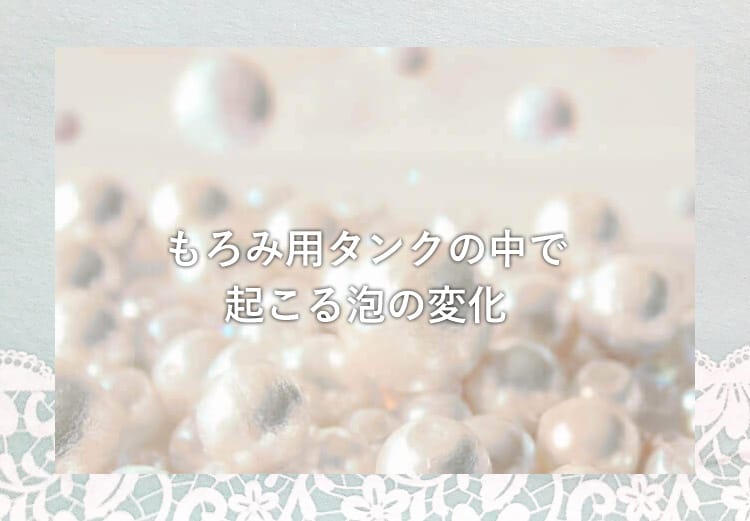
In the process of alcohol fermentation, Moromi will show various changes.
① Streaks
After the attachment,After about 2 to 3 days, alcoholic fermentation by yeast begins in earnest..
At this time, the surface of the moromi is still hard,It is pushed up from the bottom by fermentation and breaks, and several streaky bubbles appear on the surface. This is called “muscle foam”. It is also sometimes called as “Aoi bubble”.
② Water bubbles
About 3-4 days after the delivery,White and light foamWill spread over the entire surface. This is called “water bubbles”.
③ Iwaawa
After passing through the water bubbles, saccharification progresses,Sugar is added to moromi and the viscosity of the foam increases..
This bubble is called “Iwa bubble” because it gradually thickens and rises to a higher position, and it looks like a rock.
④ High foam
As fermentation increases, the momentum of carbon dioxide increases, so the position of the bubbles rises further from the rocks. This state is called “high bubble”.
Since yeast is contained in a large amount of bubbles, you have to take care to prevent the bubbles from overflowing by performing a work called “foam erasing”..
A fan-like tool called a “foam eraser” is used for defoaming.
⑤ Bubble falling
When high bubbles pass, the bubbles will decrease in about 1 days. This is called “dropping bubbles”.
The fermentation goes past the peak, and the amount of alcohol produced eliminates the stickiness of the foam, which reduces the foam..
⑥ Tamawa
As the bubbles fall, then on the surface of the moromiBubbles like soap bubblesCan float. This is called "ball bubble".
Around this time,The solid part is almost gone and the moromi is almost liquid.
⑦ Chirimen foam
Past the jade bubbleThe progress of the fermentation will be moderate, and the amount of carbon dioxide produced during the fermentation will also decrease.. The fine bubbles that form on the surface at this time are called “chirimen bubbles”.
じ Ground
At this time, the fermentation hardly progresses, so the foam hardly rises. thisThe state where the surface is flat is called "ground". It is also called “Shaved”.
⑨ Lid
Finally, the final stage of Moromi. At this time,Yeasts are killed by the alcohol they produce.
At this time, dead bodies of yeast and rice residue may appear on the surface of the moromi. This is called a “lid”.
Difference in taste that changes with the temperature of moromi

As alcoholic fermentation progresses, fermentation heat is generated and the temperature of moromi rises gradually. Therefore, extreme care must be taken when controlling the temperature.
Typically,The lower the temperature of the moromi, the more slowly the fermentation progresses, and the lighter and lighter taste becomes less.There is a trend. Daiginjo sake that aims for a beautiful tasteLow temperature such as below 10 ℃So we will slowly ferment over a long time.
Conversely,If the temperature is high, it will be difficult to manage the temperature of the moromi, or alcohol fermentation will be promoted too much, resulting in a taste with a lot of taste.There is a trend.
The temperature at which the mash is fermented depends on what kind of sake you want to make.
Always determine the state of fermentation accurately from the surface condition and taste, as well as the results of component analysis, and control the fermentation to achieve the desired liquor quality.Important work that requires high skill and skilled experienceIt can be said.
Add brewing alcohol
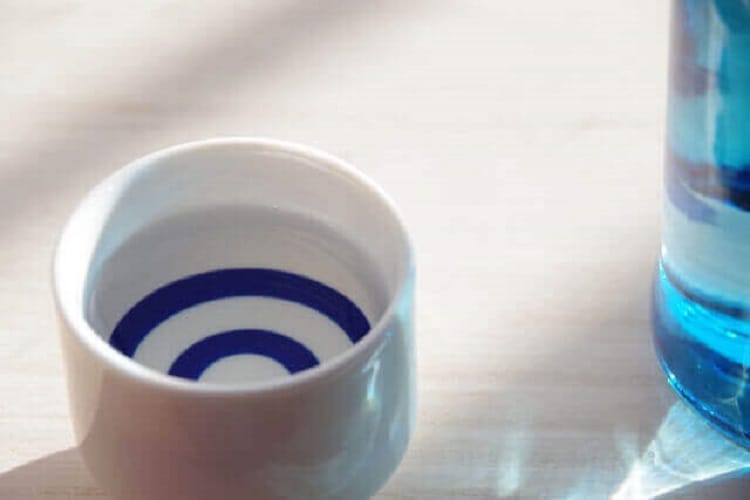
For sake that adds brewing alcohol such as brewed sake,Added just before moromi is squeezedTo do. Although it may not be as good as brewing alcohol, please imagine a tasteless and odorless alcohol called Kojo Shochu. The process is almost the same for both.
First of all, how to makePrepare corn and molasses by fermenting and distilling them, and having an alcohol content of about 45% (called "crude alcohol").
Most of these are imported from overseas such as Taiwan and Brazil. Imported crude alcohol has a high alcohol content in Japan using a continuous still.About 95%Distill until
You may have been surprised to hear that it is 95%, but when adding it to moromi, add water so that the frequency is about 30%.
By the way, the amount of brewing alcohol added is stipulated. For example, in this brewing sake, the upper limit is set to "10% or less based on the total weight of white rice".
The reason for adding alcohol for brewing is to lighten the taste or finish it in a dry taste.
In addition, The purpose is to extract aroma componentsThere are many cases where it is added. This is because when brewing alcohol is added, ginjo aroma adsorbed on the solid portion of the moromi can be extracted.
Almost all of the exhibited liquors have been added with alcohol for brewing at national new sake review meetings, etc.
The alcohol addition itself isActually it has been done since the Edo period. However, since there was no alcohol for brewing at this time, shochu was added.
My goal is,Prevention of liquor forgeryis. This technique was started after the discovery that liquor is hard to rot when shochu is added, and is called “Hashira Shochu”.
Even today, there are sake breweries that make Japanese sake using this shochu.
The place where we put particular effort isKinpo Sake Brewery (Shibata City, Niigata Prefecture)is. Kinjo Sake Brewery has a long history not only in Japanese sake but also in the production of shochu. You can make it because it ’s such a brewery.
It is said that it took 3 years to complete the “Kinmasu Akari Label” made with pillar shochu. If you find a gem that is a fusion of Japanese sake and shochu making technology, please try it. The sake world will spread more and more and it will surely be fun.
By the way, it seems that it appeared in the drama version of the popular manga “Wakako Sake” depicting the days when women enjoy sake alone.
Not only three-stage preparation! There are also ways to prepare more than 4 times
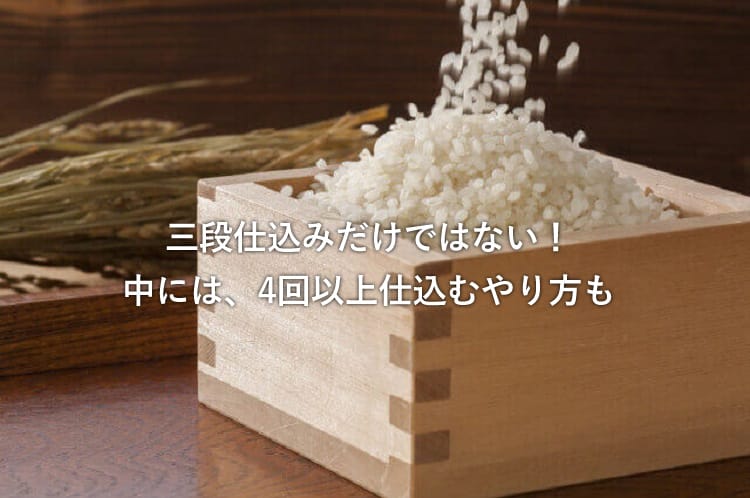
Three-stage preparation is the most standard method,There is also a "four-stage preparation" that increases the number of preparations.. They are,How to make steamed rice after the third stage is finished.
As the number of times increases, the name will change to "5-stage preparation" or "6-stage preparation". There is even a surprising “ten-step preparation”.
This four-stage preparation was once done in many sake breweries, but because it takes time and effort, the number of sake breweries that gradually quit increased.
However, despite the effort and cost, there is a purpose to increase the number of times like a four-step preparation. It is mainlyTo finish the sake with a sweet taste.
~ Reasons for sweetening with more preparations ~
So why can you make sweet sake by adding steamed rice?
To begin with, sake is made by a fermentation system in which rice bran converts rice starch into sugar and yeast produces alcohol from the starch. That meansRice is the source of sugar, and the sugar in rice becomes alcohol.
However, yeast has the property that, as fermentation progresses, it is gradually weakened and killed by the alcohol it produces. Without the yeast, no matter how much sugar the candy produces, it cannot be converted to alcohol.
That meansSugar added after the death of the yeast will be accumulated in the mash without alcoholic fermentation..
Therefore, no matter how much steamed rice, which is the source of sugar, is put into the tank where the three-stage preparation is finished,Since it remains in the liquor as a sugar, it will be a sweet liquor.
~ What is rice used for four-stage steamed rice? ~
There are 2 types of steamed rice used for four-stage charging.
one is,"Uruchi rice"is. Uruchi rice means ordinary rice that we Japanese usually eat as a staple food. Sake brewing suitable rice is a kind of glutinous rice.
One of the most popular sakes made in four steps with glutinous rice is “Kikusui's Four Steps” from Kikusui Sake Brewery (Shibata City, Niigata Prefecture).It has a light and soft sweet taste and is easy to drink even if you are not familiar with sake..
The other is"Stick rice"is. Sticky rice is rice used for rice cakes, red rice, rice bran, etc., and is characterized by its stickiness compared to glutinous rice.Using glutinous rice will produce a sweeter liquor..
One thing that can be said to be a synonym for sake brewers using glutinous riceHanasen Shuzo (Minamiaizu-gun, Fukushima Prefecture)is. Hanasen Sake BreweryWe carry out "Stick rice four-stage preparation" for all brandsIt ’s a sake brewery like no other in Japan. The steamed glutinous rice is put in hot and charged, creating a refreshing yet delicious taste with rich tenderness and richness.
Maruze Sake Brewery (Nakano, Nagano Prefecture)Is rare even in the whole country"Stick rice cooked in four steps"It is brewed in the way. This is a preparation method in which a round rice ball is made with steamed glutinous rice (about 80 ° C) and then melted in the moromi of the mash to bring out the elegant sweetness and umami of the glutinous rice.
Also, the “Himei” brandIshizuka Sake Brewery (Amagasaki City, Niigata Prefecture)However, in a four-stage process using glutinous rice, we produce various types of sake, including unfiltered raw sake, genuine brewed sake, and sake.
-Used for other than steamed rice-
Up to this point, we have introduced how to add additional steamed rice.In addition to steamed rice, there are ways to add enzymes, amazake, sake lees, sake mothers, water, etc..
When adding enzymes, add water and enzymes to steamed rice and saccharify them before adding them to moromi. When adding amazake, add hot water to koji and steamed rice to make amazake and then add it to the moromi.
It seems that sake lees were often added to increase brewing efficiency and flavor.
There are other methods of making moromi
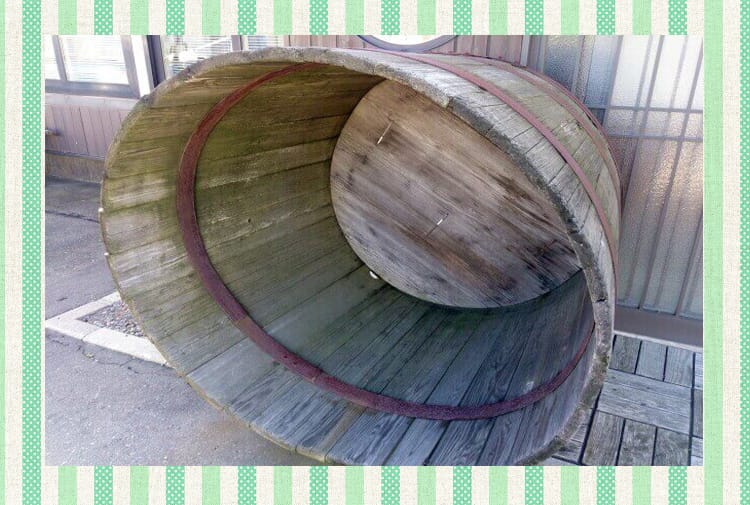
There are many other ways to make moromi. Here are some typical examples.
① Kiso preparation
In some cases, a wooden basket is used instead of a commonly used enamel tank.
The number of breweries that revitalize Kiso has increased, focusing on the unique flavor and deep flavor unique to Kiso, and the fact that the taste is complex and rich in character..
Above all, the shift to full-scale kiso preparationsShinsei Sake Brewery (Akita City, Akita Prefecture) known for “No.6”.
Since the introduction of the wooden "six shaku" in 2013, we have expanded the use of wooden caskets. A dedicated warehouse for Kiso was established, and several units were switched from a hollow tank every year. From 2020, we started to manufacture Kiso using locally produced Akita cedar, and in the future, all Kiso It seems to be planned.
② Liquefaction preparation
Liquefaction preparation is how to make moromi without using steamed rice. White rice and water are put into a liquefier such as a mixer and crushed, and liquefied with an enzyme agent while raising the temperature. After the liquefaction is completed, cool it and prepare it in the mash tank.
In the usual method using steamed rice, it is not easy to control the fermentation because the mash becomes solid immediately after charging.
But,When white rice is liquefied, it can be stirred evenly from the beginning.This makes accurate fermentation management easier.
In addition, It is possible to work with a small number of people and reduce capital investment, so it can be done at low cost and does not take many days.There is also a merit that. It is also known as “molten rice” or “himehime”.
③ roasting
Instead of steaming the raw rice, the heated white rice is heated with hot airis. Hot air temperatureAbout 290 ℃. Heat treatment at a stretch in about 45 seconds.
A technique developed by Takara Shuzo (Kyoto City, Kyoto Prefecture)is. It seems that it can be made into a light and dry liquor with good crispness and little miscellaneous taste.
